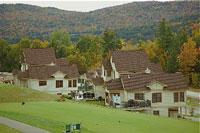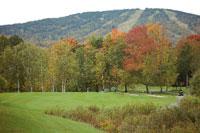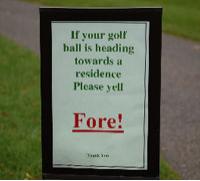|
Reader Feedback
We want to make this newsletter as useful as possible for you. If you have comments, critiques, suggestions or observations about the newsletter, please email them to me at This email address is being protected from spambots. You need JavaScript enabled to view it.. I promise to respond quickly.
Autumnal golf
If you visit my web site, you know I have been taking advantage of the season and stopping by dozens of golf clubs in New England. The leaves are beautiful, and the golf is not too shabby either. I hope these photos capture a sense of the beauty of this part of the country at this time of the year.

At Owl's Nest in Camption, NH, you get the golf course, the mountains and roomy condos starting in the $300s.

Homes at the sleek Vermont National Golf Club in South Burlington, VT, have great views of the course and the Green Mountains.

Golfers and homeowners alike have choice views of the water-surrounded finishing hole at Ballymeade Country Club in East Falmouth, MA.

Two-season athletes will enjoy both the slopes and the slope rating at Stratton Mountain, whose 27 holes of Geoffrey Cornish golf are both fun and challenging.

Unless I am taking a nap with the window open!
|
One golf home or two?
In this market, anything’s possible
I have spent the last three weeks making quick visits to golf clubs throughout New England. I’ve played only three rounds, one on Cape Cod at a club called Ballymeade, then at Stratton Mountain, in the mountains of central Vermont, and finally at Owl’s Nest, part of a golf community just off I-93 in central New Hampshire. I have put more than 2,000 miles on my car in those two weeks, but the driving has been made a lot easier by some glorious colors on the mountains. I have spent time in the western Carolina mountains, which are beautiful, but they have nothing on the Green Mountains and White Mountains of New England.
I am expanding my geography to include northeastern U.S. golf communities and independent courses. The more conversations I have with Baby Boomers, the more I learn that they are seeking alternatives to Florida and other parts of the south, where the heat is pretty much unbearable in summer. I was matched for my round at Stratton Mountain with a gentleman from Austin who said he and his wife were in Vermont to enjoy the fall colors of the changing leaves. He added that it was just too hot to play in Austin in the summer and early fall. Developers and marketing managers I have talked with in these past few weeks say they are targeting Floridians especially. You might have read that, in 2008, Florida had its first net loss of residents in the last five decades. Some, it seems, are moving well north.
When the housing and stock markets stabilize, which they will do eventually, some golfing couples might choose to retire to two homes –- one north, one south –- where they can play golf year-round. Falling home prices have made this possible for many, and the serious golfer with a bit of a vagabond soul (and a little extra money to spend) will appreciate playing a flattish course in the winter and a roller coaster course in the mountains in summer. Those who plan to spend, say, $800,000 on a single home, could live in two nice places north and south for that amount, although the extra set of taxes will add a bit to the bottom line expenses. And, of course, neither $400,000 home will be as lavish or large as the $800,000 choice.
I don’t expect the number of golf rounds played will catch up with the oversupply of courses around the country for some time; those who don’t absolutely need to join private clubs will find a great array of semi-privates, and at ever more-competitive rates. Generally speaking, the many semi-private clubs I stopped at in New England don’t charge much more than $60 a round, cart included. Very few charge an initiation fee or more than a few thousand dollars in annual fees.
Even with the current housing market, I was surprised at the reasonable prices I saw in Vermont real estate listings, although property taxes are high in the state (as I always preach, look at the total cost of living, including the relative cost of real estate, not just taxes). Some large Victorian homes were priced in the $300s and did not appear to have structural or cosmetic issues. Other homes in small towns, and not far from the local golf clubs, were priced similarly. Of course, these small towns do not have the abundance of services you find near bigger burgs. But that, after all, is the point of living in a place like Vermont, at least part-time. Small towns lead to big relationships with your neighbors, the owner of the general store, and the couple who tap the local maple trees for the best syrup you will ever taste. And far from the traffic jams of places with overbuilt developed communities, a place in postcard New England helps recharge the batteries.
Some of the golf communities, many of which are also skiing communities, feature home prices much more reasonable than for comparables in the southern U.S. At Owl’s Nest, for example, where I spent two nights and played one of the best public courses in New England, large condominium town homes with views of the mountains and golf course begin in the $300s. Single family homes are available from the $400s. The golf course, designed by Mark Mungeam, who came out of the Geoffrey Cornish shop, is beautiful and challenging and, most of all, fun for all types of players. Popular ski areas are just 20 minutes away.
Some golfers are skiers too, and in Vermont and New Hampshire especially, you are never more than a few miles from splendid skiing (Florida dwellers will recognize the traffic patterns leading to New England ski resorts on winter weekends). Although the mountains of the Carolinas and the far western regions of Virginia have their own ski resorts, they will not appeal to the halfway serious skier the way Killington, Stratton, Stowe, Mount Snow and other New England peaks will.
Developers north and south are negotiating seriously on price just to move their inventories. That is opening up the possibility of dual-home ownership for those with an interest in two climates, maybe a little skiing with their golf, or just some variety. If two homes appeal to you, one should be in a single-family home, where you can spread out a bit and not feel you are in resort accommodations all year round. At The Landings in Savannah, GA, for example, an attractive patio home is currently listed at just $299,900 for nearly 2,500 square feet and 3 BRs and 2 BAs. Joining fees for the six private and excellent Landings golf courses have been lowered to $30,000, but "semi-private" options are also available nearby, including at The Wilmington Club, a classic Donald Ross design that has been tinkered with over time, but not in a way that hides many of the master’s intentions. In many other places throughout the hot south, you will find prices have cooled on decently sized homes, in communities that you would be happy to call your primary or second home.
Sunk treasure:
Scholarly paper gives hint at how to negotiate to buy someone else’s house
I had the good fortune to meet Andy Litteral late this summer. Andy is a professor of statistics at the University of Richmond and a reader of our web site, GolfCommunityReviews.com. He invited me to stop by his office while my daughter was visiting the admissions office and taking a tour of the beautiful campus.
During our discussion about our future prospects as retired gentlemen in golf communities, I suggested to Andy that many people who otherwise would have relocated to their dream retirement location are holding out for unnaturally high prices for their primary homes. This, I argued as I always do, is causing them to miss out on a better life and, in many cases, a lower cost of living if they are considering a move from the high-priced north to the lower-priced south.
As a scholar, Andy takes a much more rational approach to such issues, and he grabbed from his desk a scholarly paper that considers the issue of irrational expectations on the part of a home seller, and how a potential buyer can use such behavior to his or her advantage. Without getting into too much detail, the paper, which is now a dozen years old and was authored by professors from four different universities, investigates “the impact that sunk costs have on negotiators’ expectations, strategies, and negotiated outcomes.” In other words, it asked, does what a seller paid for his property affect the positions of both buyers and sellers in the negotiation process?
The conclusion of the research, which studied nearly 300 subjects, was that buyers base their first and highest offers on the sellers’ purchase price; that the sellers’ lowest acceptable offer is based on what they paid for the property; and that the previous purchase price affects the final outcome of negotiations. In short, “the consideration of one’s own sunk costs may be irrational from an economic perspective” –- score one for my team! – but “the consideration of one’s opponent’s sunk costs may be strategically rational” if it predicts the opponent’s (i.e. the seller’s) actions. In short, knowing your opponent’s likely next move, as in chess, can help guide your own moves.
As much as anything, the study implies the need for any buyer to be represented by a “buyer’s” real estate agent, who will do the research for you and determine how much the seller of the home you are interested in has sunk into the property. For sellers in many such situations, assume that your opponent has such information and negotiate accordingly. In the end, rational behavior on both sides of the negotiation will result in a sweeter deal for all.
|